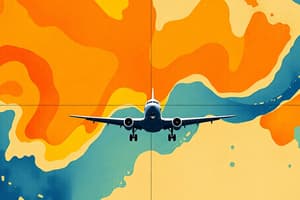Podcast
Questions and Answers
What is Controlled Airspace?
What is Controlled Airspace?
- Airspace that is prohibited for all aircraft
- Airspace with controlled dimensions where ATC service is provided (correct)
- Airspace classified as Class A, B, C, D, or E
- Airspace without any regulations
What is the altitude range for Class A airspace?
What is the altitude range for Class A airspace?
18,000' - 60,000' MSL
Class B airspace surrounds major airports.
Class B airspace surrounds major airports.
True (A)
What is the memory key for Class B Airspace?
What is the memory key for Class B Airspace?
What is required before operating in Class C airspace?
What is required before operating in Class C airspace?
What is the top altitude for Class D airspace?
What is the top altitude for Class D airspace?
What is the defining characteristic of Class E airspace?
What is the defining characteristic of Class E airspace?
Class G airspace requires ATC authorization to operate.
Class G airspace requires ATC authorization to operate.
What are prohibited areas established for?
What are prohibited areas established for?
What defines restricted areas?
What defines restricted areas?
Flashcards are hidden until you start studying
Study Notes
Controlled Airspace
- A classification system of airspace where ATC service is provided.
- Class A airspace spans from 18,000' to 60,000' MSL, primarily for IFR aircraft; sUAS flights are prohibited.
Class B Airspace
- Surrounds large major airports, requiring two-way radio communication.
- Extends from surface to 10,000 feet MSL; caters to the nation's busiest airports.
- Composed of a surface area and multiple layers.
- Memory key: Big & Busy.
Class C Airspace
- Tailored airspace usually surrounding airports with control towers; has a surface area with a 5 NM radius and a 10 NM outer circle.
- Extends from 1,200 feet to 4,000 feet above airport elevation.
- Remote pilots must receive authorization to operate here.
- Typical dimensions: 5-mile radius from the surface to 4,000' AGL, and 10-mile shelf from 1,200' to 4,000' AGL.
- Memory key: Controlled.
Class D Airspace
- Airspace from the surface up to 2,500 feet above the airport elevation around airports with operational control towers.
- Generally designed to contain published instrument procedures.
- Remote pilots must obtain ATC authorization.
- Class D airspace reverts to Class E or G when part-time control towers are closed.
- Memory key: Discuss.
Class E Airspace
- Any controlled airspace not classified as A, B, C, or D.
- IFR aircraft in Class E must be under ATC control.
- Extends from the surface up to 18,000' MSL.
- En route Class E starts at 1,200' AGL and covers most of the U.S.
- Transition Areas begin at 700' AGL near airports to protect aircraft on approach/departure.
- Surface Areas extend from the surface at non-towered airports; sUAS needs ATC authorization.
- Any Class E airspace not classified otherwise begins at 14,500' MSL.
- Memory key: Everywhere Else.
Class G Airspace
- Uncontrolled airspace not designated as Classes A, B, C, D, or E.
- Extends from the surface to the base of the overlying Class E.
- Remote pilots do not need ATC authorization to operate.
Prohibited Areas
- Defined dimensions where aircraft flight is prohibited for security or national welfare reasons.
- Published in the Federal Register and shown on aeronautical charts; marked as "P" followed by a number (e.g., P-40).
- Examples include restricted areas such as Camp David and the National Mall in Washington, D.C.
Restricted Areas
- Areas where operations are hazardous to nonparticipating aircraft; flight is subject to restrictions.
- Activities confined to restricted areas due to nature or limitations.
- Flight into active restricted areas without authorization is extremely hazardous.
- If a restricted area is inactive, ATC may allow aircraft operations without specific clearance.
Studying That Suits You
Use AI to generate personalized quizzes and flashcards to suit your learning preferences.




